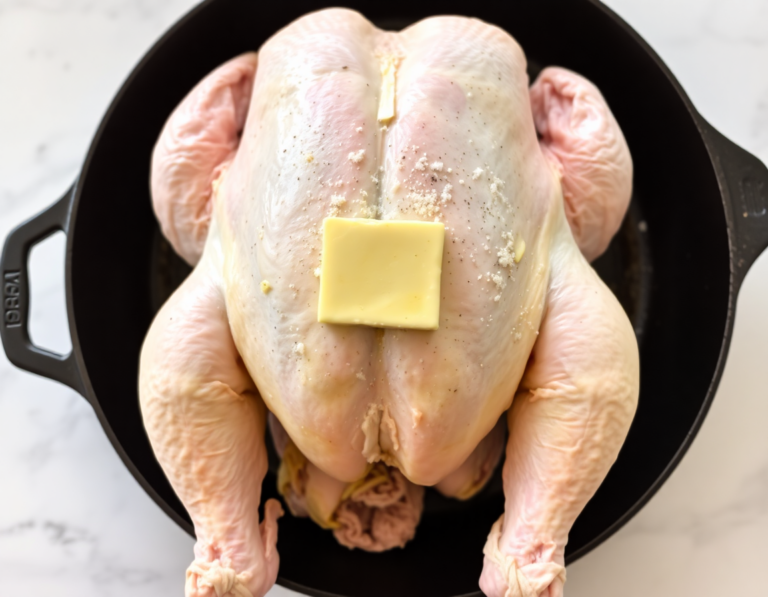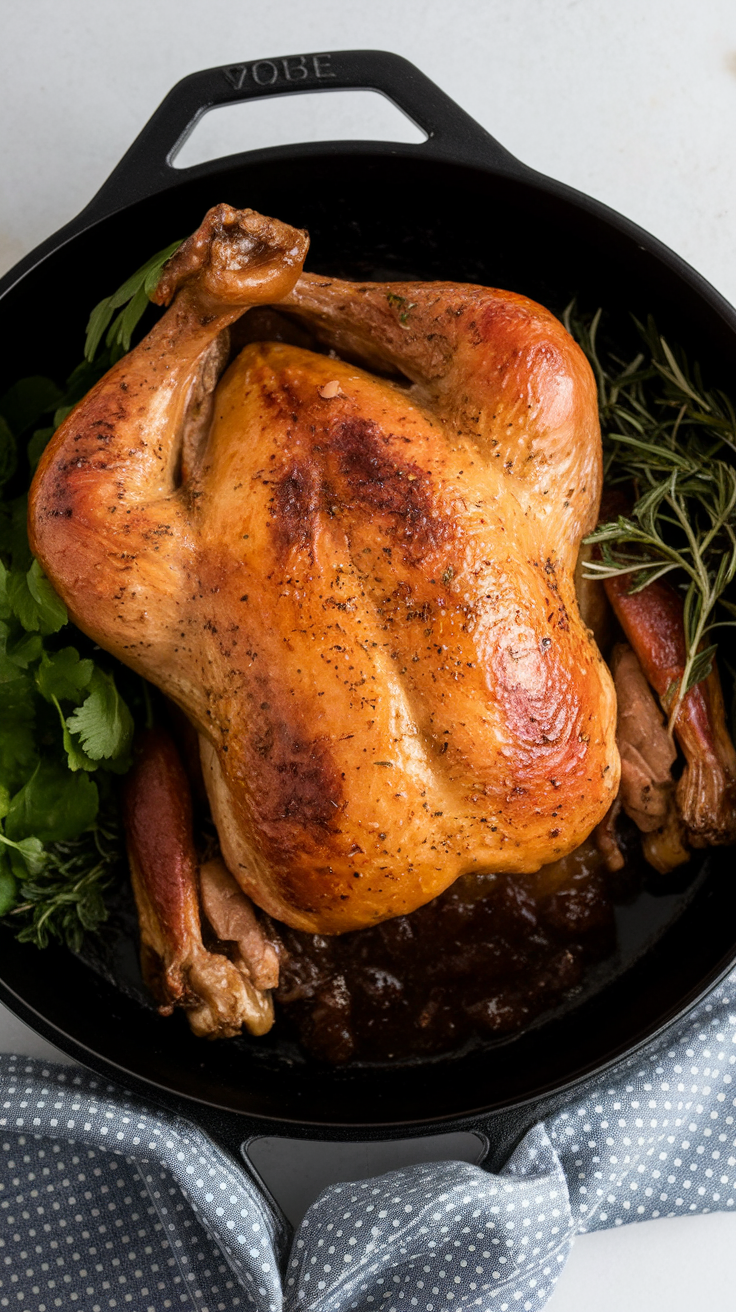Ah, roast chicken—it’s like a warm hug from the oven. The crispy skin, the tender meat, and that gravy?
Pure bliss. I mean, who needs a fancy restaurant when you can whip this up at home?
It’s like Sunday dinner any day of the week.
Steps
- Begin by preheating your oven to 425°F (220°C). Trim any excess fat from the chicken and remove any remaining pin feathers. Take out the giblets from the chicken’s cavity, then pat the chicken dry with paper towels.
- Lightly coat a cast iron skillet with vegetable oil and place the chicken in the skillet with the breast facing up. Season the inside cavity with salt and pepper, and fill it with garlic cloves, onion wedges, and fresh herbs.
- Spread butter over the entire chicken, focusing on the breast area, and season it generously with salt and pepper. Use kitchen twine to tie the chicken legs together, and tuck the wing tips underneath the chicken.
- Roast the chicken in the preheated oven until the thigh meat reaches 165°F (74°C) and the breast meat reaches 160°F (71°C), which should take about 1.5 hours. Once cooked, transfer the chicken to a carving board and let it rest under a tent of foil for 10-15 minutes.
- For the gravy, remove any large pieces of skin from the skillet. In a bowl, mix 1/4 cup of chicken broth with cornstarch and set aside. Heat the skillet on medium-high, scraping up any browned bits, and add 2 3/4 cups of chicken broth.
- Bring the broth to a simmer, then whisk the cornstarch mixture once more and pour it into the skillet. Season with salt and pepper, and continuously whisk until the gravy thickens, about 1-2 minutes. Stir in heavy cream and serve the gravy warm over the chicken and mashed potatoes.

Ingredients
- Whole chicken (4 to 6 lbs)
- Salt
- Black pepper
- Garlic cloves
- Yellow onion (cut into wedges)
- Fresh herbs (such as thyme, rosemary, sage, parsley)
- Butter
- Pan drippings from the roasted chicken
- Low-sodium chicken broth (total of 3 cups, divided)
- Cornstarch (for thickening)
- Heavy cream
Nutritional Values
Calories: 3178 | Calories from Fat: N/A | Fat: 231g | Saturated Fat: 77g | Cholesterol: 1078mg | Sodium: 1344mg | Potassium: 3248mg | Carbohydrates: 42g | Protein: 224g | Vitamin A: 2975IU | Vitamin C: 30.1mg | Calcium: 217mg | Iron: 13.3mg
FAQ
- Can I use a different size chicken for this recipe?
- Yes, you can use a smaller or larger chicken, but it should be no smaller than 4 lbs and no larger than 6 lbs. A 6 lb chicken is ideal as it provides more drippings for gravy and offers a nicely browned skin due to the longer roasting time.
- What can I use if I don’t have kitchen twine?
- If you don’t have kitchen twine, you can try using dental floss, several strands of thread, or aluminum foil rolled into a rope-like shape as alternatives, though these haven’t been personally tested.
- Why do I need a kitchen thermometer?
- A kitchen thermometer is recommended to ensure your chicken is cooked perfectly. It prevents undercooking or overcooking, ensuring safety and taste. The thigh should reach 165 degrees and the breast 160 degrees for optimal doneness.
- Can I make this recipe if I have a glass cooktop?
- If you have a glass cooktop and cannot use a cast iron skillet, an oven-safe stainless steel skillet or a small stovetop-safe stainless steel roasting pan are good alternatives.
- What should I do if the chicken skin isn’t browning?
- If the chicken skin isn’t browning as desired, you can move the oven rack up a level or briefly broil the chicken near the end of cooking. Keep a close watch to prevent over-browning. If the skin is browning too quickly, cover the chicken with a sheet of foil.
Tips
- Dry the Chicken Thoroughly: Before roasting, pat the chicken dry with paper towels to ensure a beautifully browned skin.
- Use a Kitchen Thermometer: To avoid undercooked or overcooked chicken, use a kitchen thermometer. Insert it into the thickest part of the thigh and breast, ensuring the thigh reaches 165°F and the breast 160°F.
- Broil for Extra Browning: If the chicken skin isn’t browning to your satisfaction, consider moving the oven rack up or briefly broiling the chicken towards the end of cooking, but watch it closely.
- Let the Chicken Rest: After removing the chicken from the oven, allow it to rest for 10-15 minutes before carving. This helps the juices redistribute, resulting in a more flavorful dish.
Equipment
- Cast Iron Skillet – Essential for roasting the chicken and achieving a nicely browned skin.
- Kitchen Thermometer – Recommended for ensuring the chicken is cooked to the correct temperature.
- Kitchen Twine – Useful for tying the chicken legs together during roasting.
- Oven Safe Stainless Steel Skillet or Roasting Pan – Alternative if you cannot use a cast iron skillet on a glass cooktop.
